 |
| Baby Sea Line in our path |
 |
| Landscape on Seymour |
I’ve been in the moment in the middle of brush desert with scrawny gray palo santos trees where sticks and branches have woven huge nets that becomes nests for exotic birds and bird poop paints most of the red and black rocks that you creep over for one of the most fascinating two hours I have ever spent. Seymour Island is something else. It is home to blue footed boobies and great frigate birds and land iguanas and a colony of sea lions. Last time I visited Galapagos in 2007, i missed out on the boobies and the frigates in heat. These, for me, are the stars of the archipelago. Now I am happy. Bucket list check-off.
This day started early with another boat excursion on the “Finch” with Mario the guide over waters that were calmer than last time. When we arrived at the island – (it’s on the north side of Baltra where the airport lies) it was a bump and grind kind of landing as we exited the dingy. Careful don’t slip on the red rocks. I had my trusty hiker’s stick. It’s not always easy to wield the stick because you tend to look down and don’t see the upcoming bright orange and yellow land iguana right in your path. That’s a heart stopper.
 |
| Really Blue Feet |
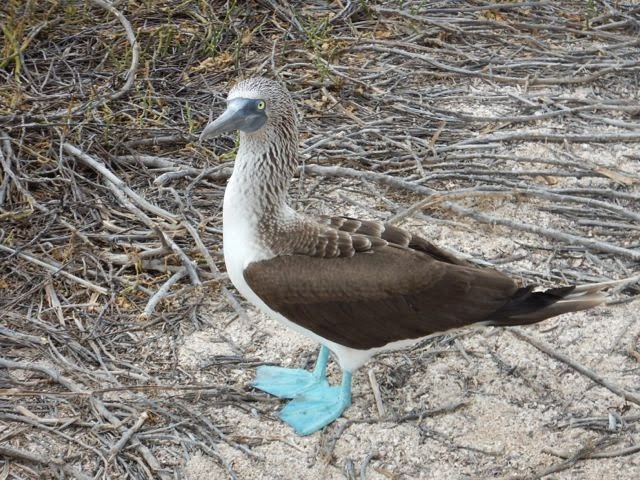 |
| Blue Footed Boobie |
We had not walked five minutes, passing a few young lounging sea lions (no seals in Galapagos, we are reminded) until we sneaked up on a blue-footed boobie. Actually we didn’t have to sneak. He was not perturbed that we were there. He was doing the boobie dance – he lifts one foot then the other and shakes and whistles. He was looking for a girl-friend and posing and cleaning himself with his long pointed beak. This one was a young one had lost all of his white baby fuzz, it’s white and blue almost albino eyes piercing us, and his webbed feet were really Grizzlies light blue. I mean it. These are amazing creatures. And just a few steps down was a baby boobie completely covered with white down fur trying to wobble on his feet sufficiently to get his wings to hold up and maybe catch a breeze. He is on his own already. They will start getting adult feathers about this time and once they are covered with them, then flying is easy. They compete against the frigate, who often steals the fish the mom’s have brought for their youth. In the feeding moments, you can hear the babies cry out so the parent knows where the chick is, as if they’d forget. But she fights those larger beasts and the fish oil helps the chick to grow quickly. If I have a favorite bird, it’s the boobies by far.
 |
| Baby Boobie |
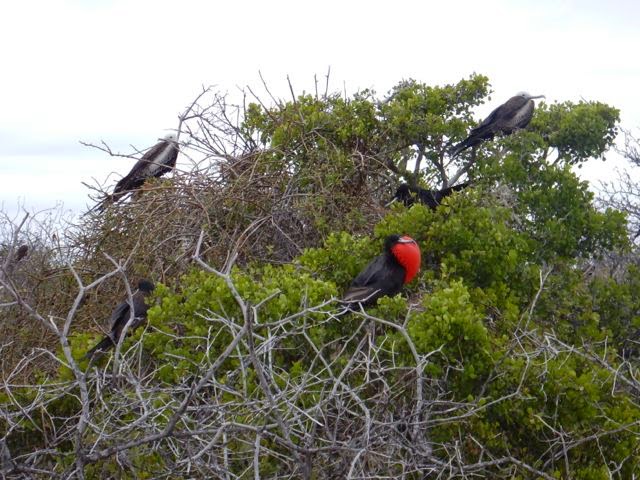 |
| Trees alive with Frigates |
Then as I looked up at the scrabbly landscape, it was a Wow! moment again. Resting on the nests of sticks (cemented by guana or bird poop) were not only boobies but dozens of Frigate birds – and all the males were in heat. How did I know? There was red balloons-like pouch under their throat about the length of my leg. (It shrinks to a red stripe off-sex-season.) These are really matriarchal societies. Females rule for it’s up to them to choose the most impressive male. Female Frigates are less decorated (they are doing the picking of the males) and have white chests. She does have a red ring around her eye. Frigates in the mating period beat on their red chests with their beaks so it sounds like a drummer hitting the sides of his kettle drum. Once the pair has mated, there is about 20 days courtship when everything is hunk-dory and the female gets all the attention as her mate searches for the best sticks to make the best nest in the neighborhood. This is why older males are preferred. They know what they are doing. The younger guys, tho maybe snappy to look at with redder chests, are bumblers when it comes to nest building. (Yeah, the ornithologists know these things.) then comes the mating and the single egg is laid in a stick nest in a low tree. They share sitting on the egg, the other one hunting for fish, for 55 days. When the chick cracks through, then it’s feeding time and both parents fish and regurgitate the oil from the fish and feeds it to the chick through a strange dance of beaks down the throat. In about 160 days the chick is developed sufficiently to be able to fly and hunt for his own meal and then there is a divorce among his parents and they look for next partners.
 |
| My Chests Bigger than Yours |
 |
| Gotta ya covered, baby |
THe Great Frigates are kin to Pelicans and are called “vultures” of the sea. They can live in the heights of the sky and wind without much effort for their wingspand is as wide as an albatross. One happy Frigate who had finally been chosen for his deep red extreme ballooned appearance was protecting his darling and his wing spread was a long as a human bed. Frigates spend most of their time in the sky gliding in circles not only diving for unsuspecting fish but also robbing the fish of hunting boobies. (It’s a dog eat dog world out there). So these birds are called “cleptoparasitism.” Small fish they can catch by swiping their curved beak across the surface of the water.
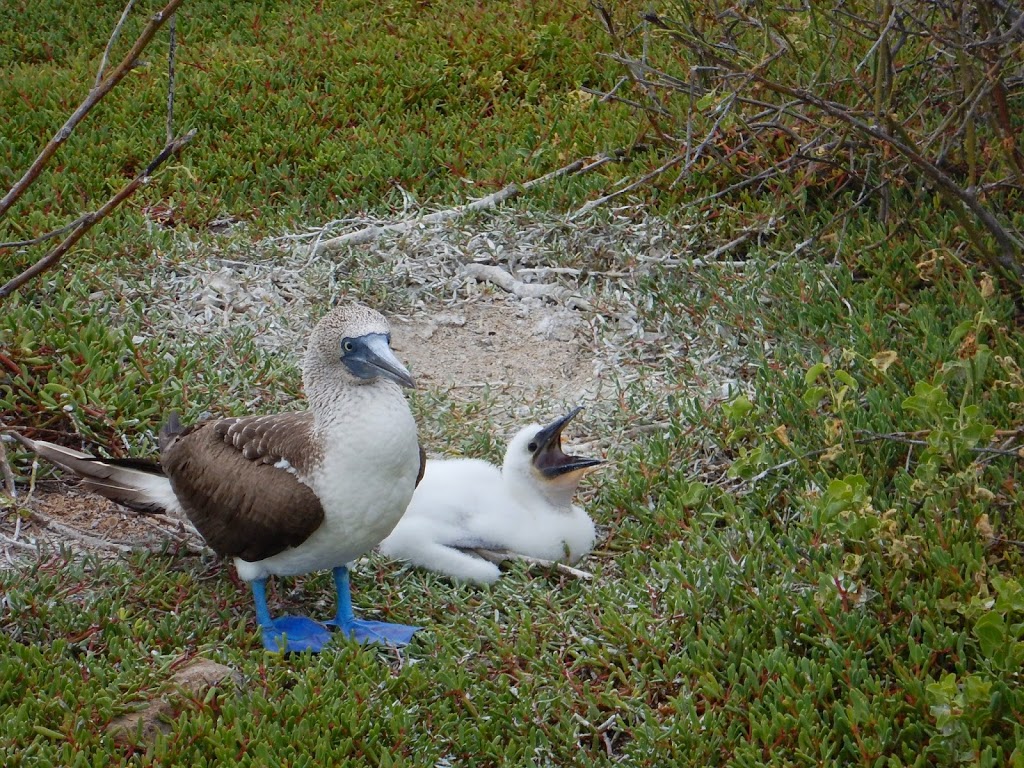 |
| Mom and Babe Boobies
|
Everything God pre-ordained is so perfect. It’s a shame humans must destroy or damage the animal life for greed, profit and thinking they know better. The best way to understand this beautiful cycle of life is to visit Galapagos, but, yet, is the human contact detrimental to their preservation for the future? Man introduced rats, dogs, cats, g oats, pigs, cows , all of which are detrimental to the natural inhabitants of these islands. And there is the erosion caused by wind, sea and rain, so the worse weather becomes in other parts of the earth, it plays the same tune in Galapagos.
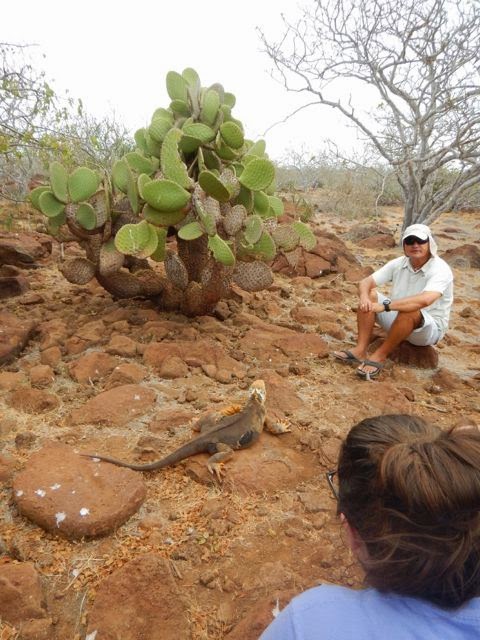 |
| Mario and the Iguana |
After tripping over lounging young sea lions who didn’t want to move (like dogs in the middle of the road), and saluting the excruciatingly ugly old iguanas, one old guy waiting for the prickly pears to drop at the Opuntia cactus that he claims as his territory, we sailed to Bachas on northern part of Santa Cruz to see if we could see, once again, flamingos in the lagoon. But it wasn’t a bummer. Mary and a few of the young kids went snorkeling in the black volcanic rocks on an ideal beach. She saw sea urchins, parrot fish, one stone fish, damsel fish and other gorgeous colorful sea creatures. I wandered the beach trying to catch Ghost crabs that run fast on the beach and as soon as you approach they leap down a hole (a perfect O-hole) with maybe a claw or two still hanging from the top to see if you are going to pass by. Also in the black rocks were marine iguanas but they are so camouflaged unless they move, can’t see them.
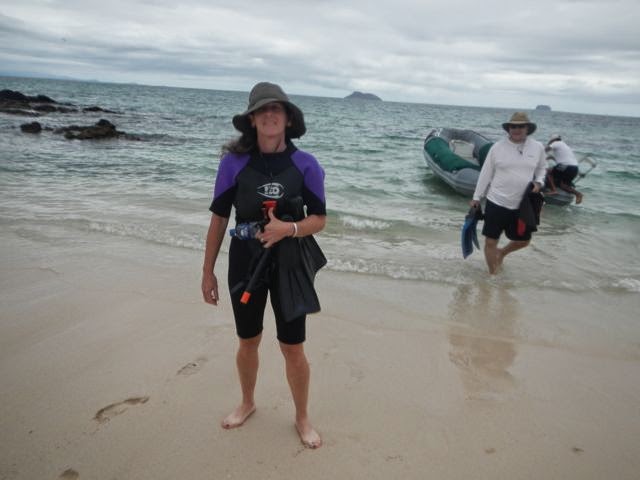 |
| Mary ready to snorkel |
A great final excursion in Galapagos. Back at the Safari Camp we were able to learn from the chef how to make his terrific cerviche. Cervechi is never the same. Each chef has his secret ingredient, some with broth, some with a soupy sauce, some with just plain lime juice. It is all just delicious. Living without regular internet has been difficult. One corner of the lounge there is a version of, but everyone is trying to get on it at once. (although there are only about 2 dozen guests in this unique place. ) That and the constant wetness, the never-stop drizzle (only up high in these highlands), were challenges for us. But we survived and are thankful.











